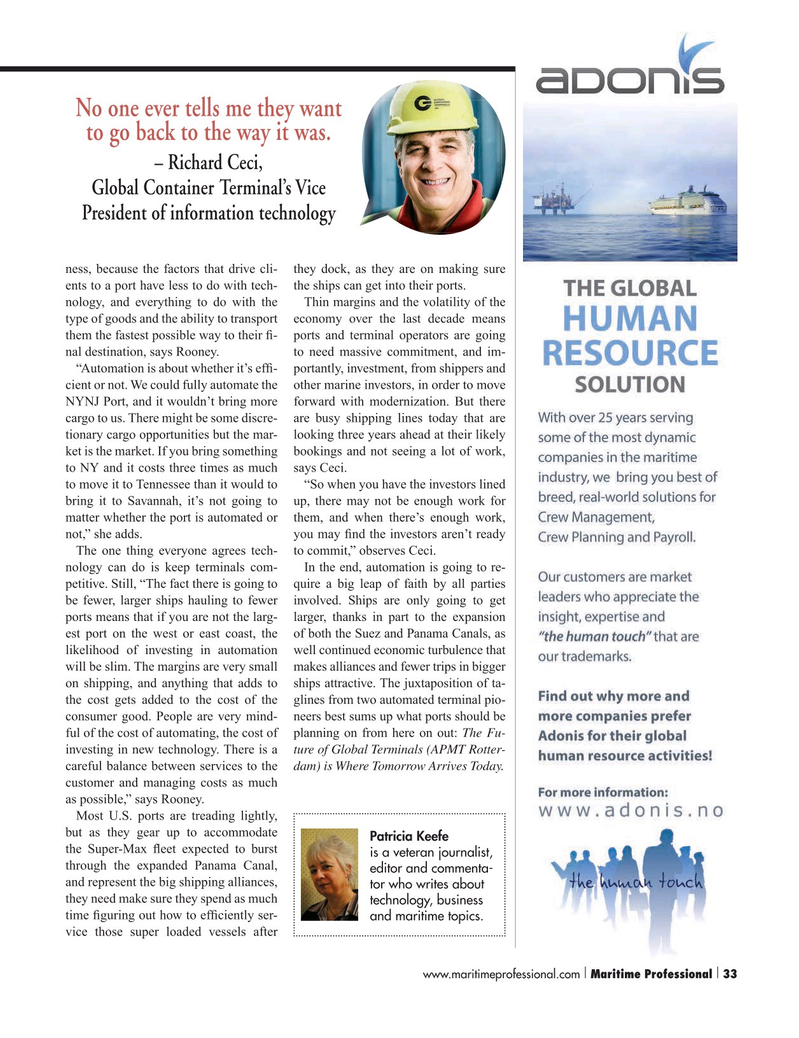
Page 33: of Maritime Logistics Professional Magazine (Q3 2015)
Read this page in Pdf, Flash or Html5 edition of Q3 2015 Maritime Logistics Professional Magazine
No one ever tells me they want to go back to the way it was.
– Richard Ceci,
Global Container Terminal’s Vice
President of information technology ness, because the factors that drive cli- they dock, as they are on making sure ents to a port have less to do with tech- the ships can get into their ports. nology, and everything to do with the Thin margins and the volatility of the type of goods and the ability to transport economy over the last decade means them the fastest possible way to their ? - ports and terminal operators are going nal destination, says Rooney. to need massive commitment, and im- “Automation is about whether it’s ef? - portantly, investment, from shippers and cient or not. We could fully automate the other marine investors, in order to move
NYNJ Port, and it wouldn’t bring more forward with modernization. But there cargo to us. There might be some discre- are busy shipping lines today that are tionary cargo opportunities but the mar- looking three years ahead at their likely ket is the market. If you bring something bookings and not seeing a lot of work, to NY and it costs three times as much says Ceci. to move it to Tennessee than it would to “So when you have the investors lined bring it to Savannah, it’s not going to up, there may not be enough work for matter whether the port is automated or them, and when there’s enough work, not,” she adds. you may ? nd the investors aren’t ready
The one thing everyone agrees tech- to commit,” observes Ceci.
nology can do is keep terminals com- In the end, automation is going to re- petitive. Still, “The fact there is going to quire a big leap of faith by all parties be fewer, larger ships hauling to fewer involved. Ships are only going to get ports means that if you are not the larg- larger, thanks in part to the expansion est port on the west or east coast, the of both the Suez and Panama Canals, as likelihood of investing in automation well continued economic turbulence that will be slim. The margins are very small makes alliances and fewer trips in bigger on shipping, and anything that adds to ships attractive. The juxtaposition of ta- the cost gets added to the cost of the glines from two automated terminal pio- consumer good. People are very mind- neers best sums up what ports should be ful of the cost of automating, the cost of planning on from here on out: The Fu- investing in new technology. There is a ture of Global Terminals (APMT Rotter- careful balance between services to the dam) is Where Tomorrow Arrives Today.
customer and managing costs as much as possible,” says Rooney.
Most U.S. ports are treading lightly, but as they gear up to accommodate
Patricia Keefe the Super-Max ? eet expected to burst is a veteran journalist, through the expanded Panama Canal, editor and commenta- and represent the big shipping alliances, tor who writes about they need make sure they spend as much technology, business time ? guring out how to ef? ciently ser- and maritime topics. vice those super loaded vessels after www.maritimeprofessional.com Maritime Professional 33| | 18-33 Q3 MP2015.indd 33 9/18/2015 9:54:12 AM

 32
32

 34
34
